Abstract
Propionibacterium acnes (oral and/or parenteral administration) had a modulating effect on antibody-and cell-mediated immune responses of germfree (GF) and monoassociated (MA) rats. In conventionally reared rodents, parenteral injection of killed P. acnes stimulated the splenic plaque-forming cell response to sheep erythrocytes. However, in GF rats and in rats monoassociated with viable P. acnes, parenteral injection of killed P. acnes antigen inhibited the plaque-forming cell response to sheep erythrocytes. When compared with the responses of GF control rats, splenocytes from GF rats parenterally injected with P. acnes antigen had a decreased in vitro blastogenic response to phytohemagglutinin and concanavalin A and an increased blastogenic response to homologous bacterial antigens. Conversely, a parenteral injection of P. acnes antigen into P. acnes MA rats resulted in an increased splenocyte blastogenic response to phytohemagglutinin and concanavalin A but not to homologous (P. acnes) antigens. Thus the presence or absence of intestinal antigenic stimuli (in MA and GF rats) had a modulating effect on the immune response to a parenteral injection of P. acnes antigen.
Full text
PDF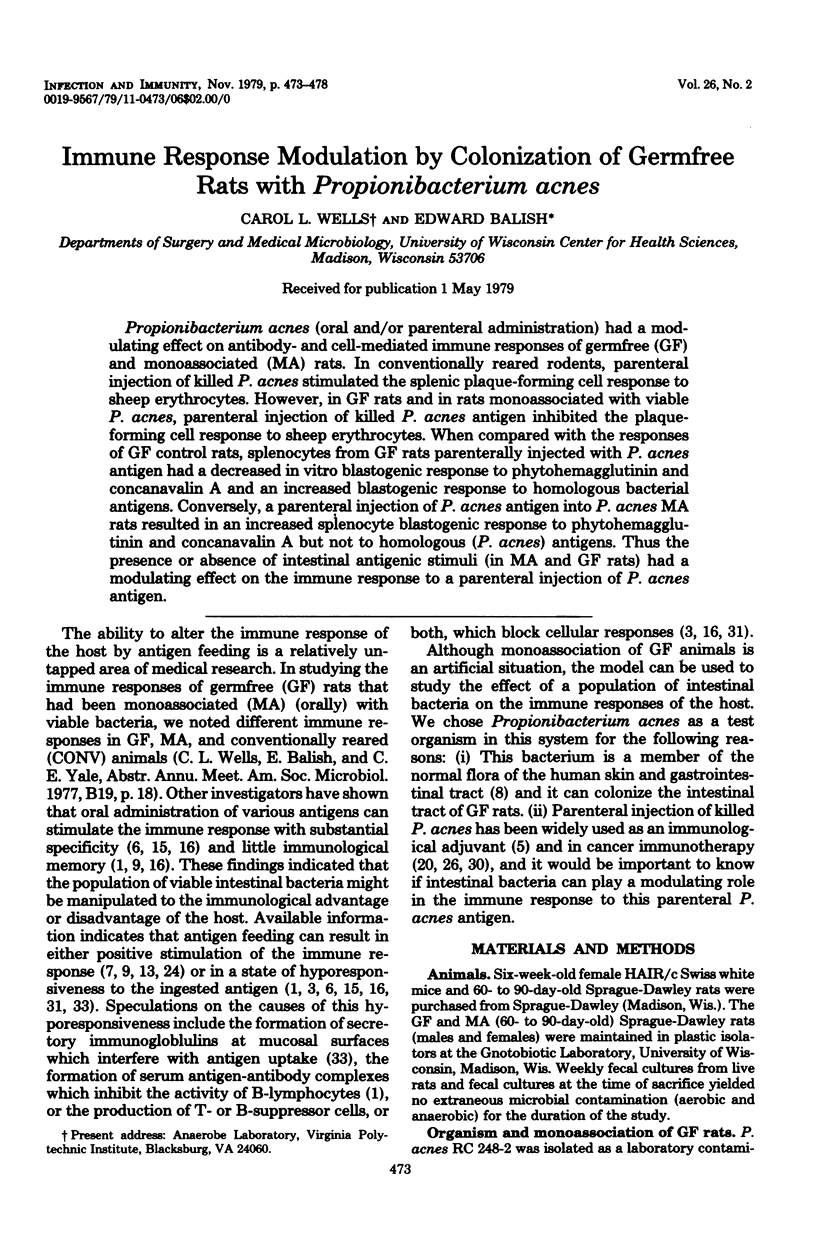
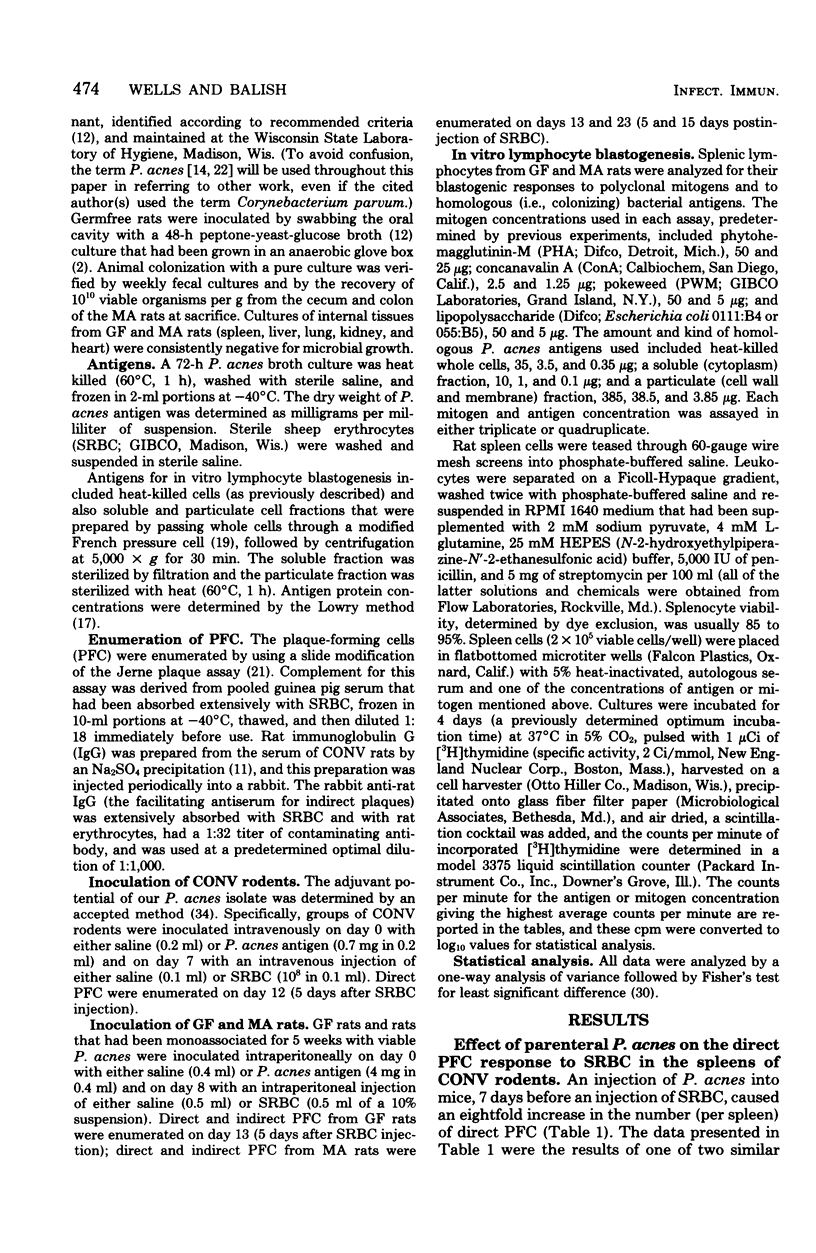
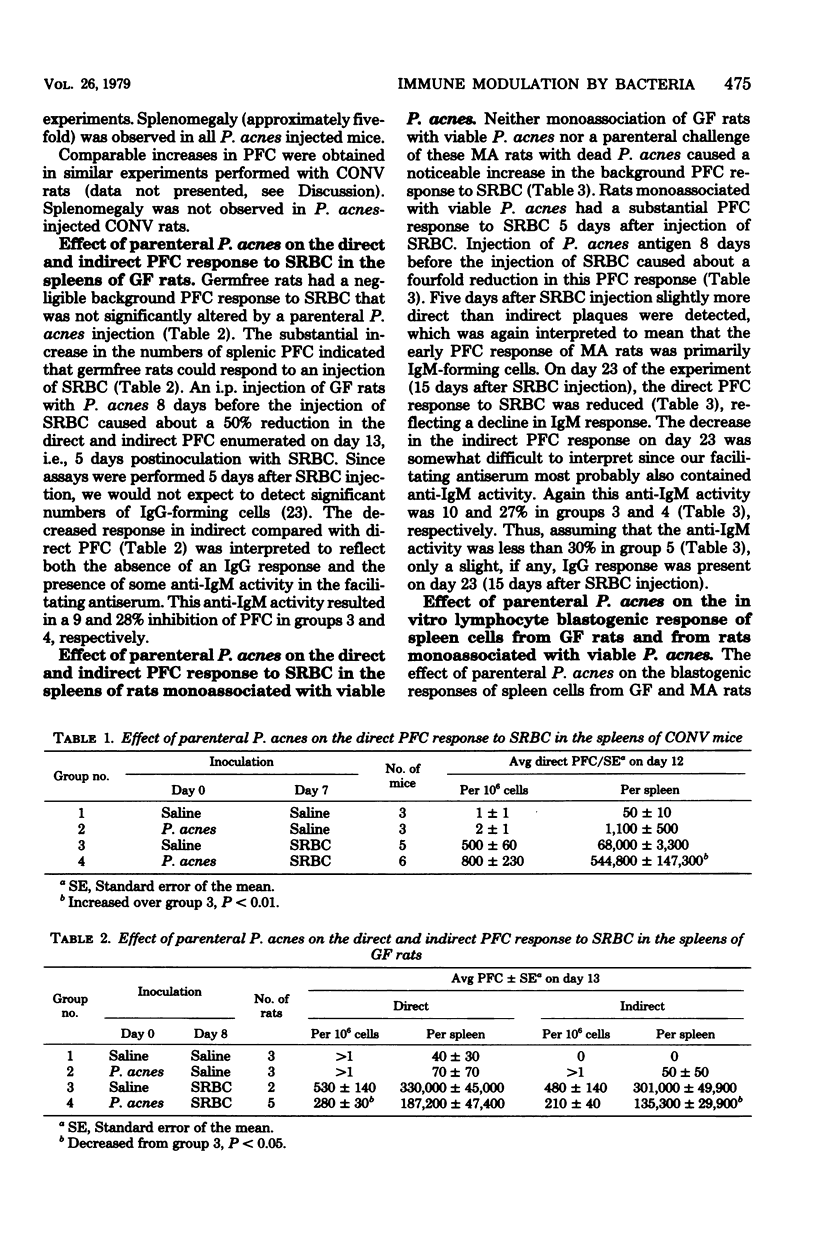

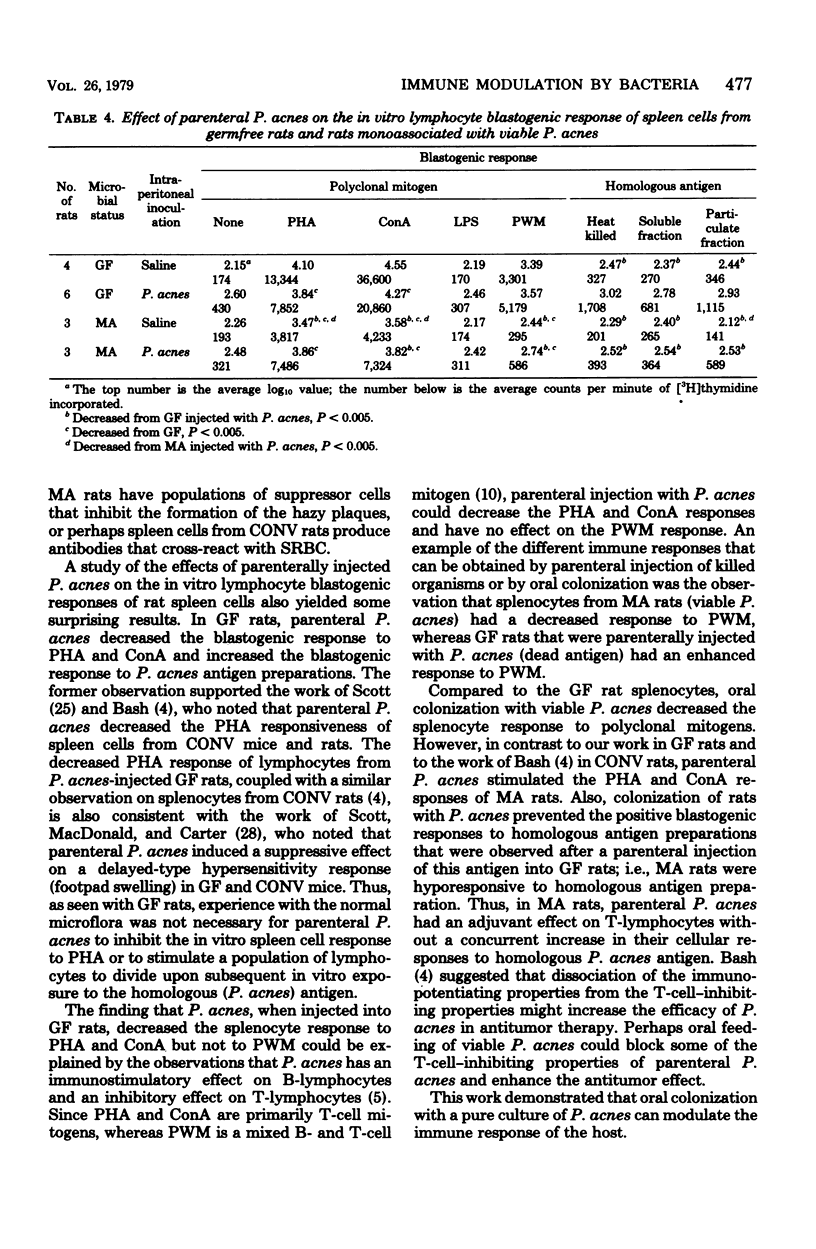
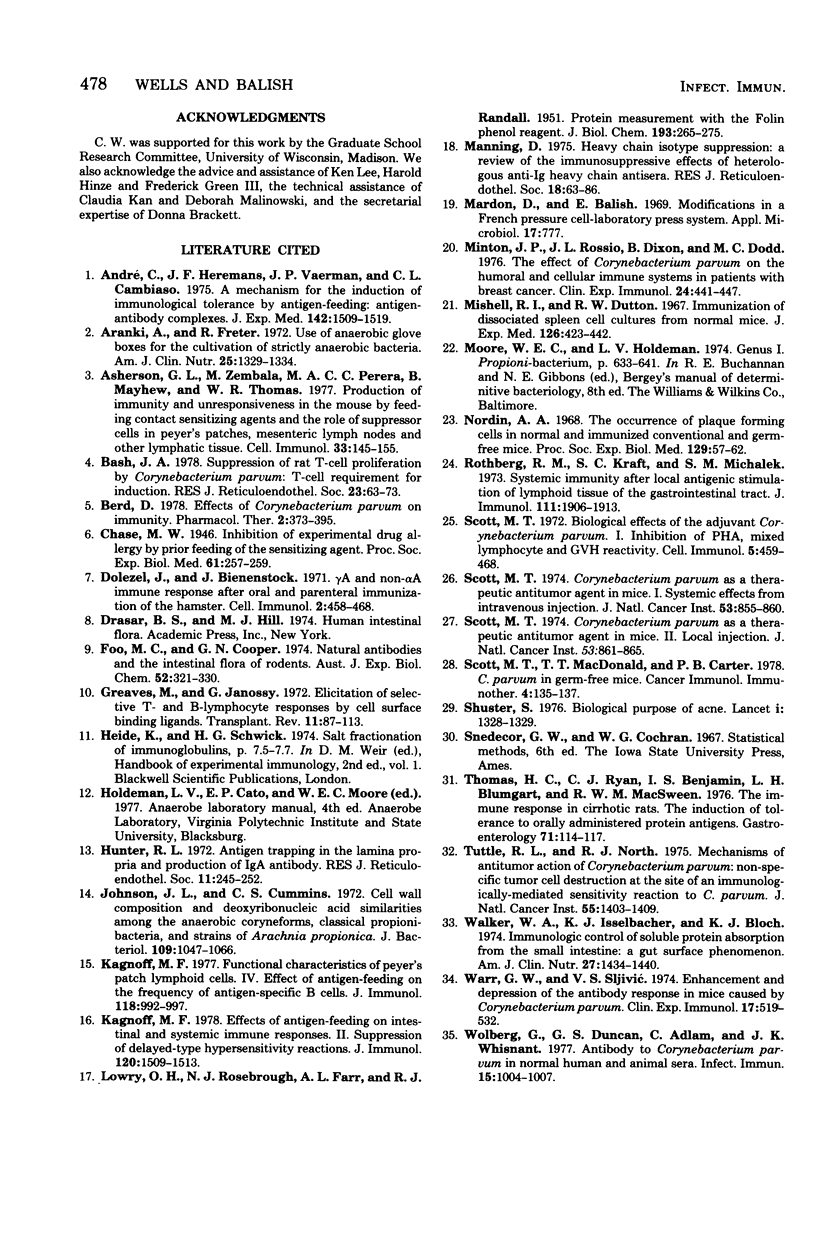
Selected References
These references are in PubMed. This may not be the complete list of references from this article.
- André C., Heremans J. F., Vaerman J. P., Cambiaso C. L. A mechanism for the induction of immunological tolerance by antigen feeding: antigen-antibody complexes. J Exp Med. 1975 Dec 1;142(6):1509–1519. doi: 10.1084/jem.142.6.1509. [DOI] [PMC free article] [PubMed] [Google Scholar]
- Aranki A., Freter R. Use of anaerobic glove boxes for the cultivation of strictly anaerobic bacteria. Am J Clin Nutr. 1972 Dec;25(12):1329–1334. doi: 10.1093/ajcn/25.12.1329. [DOI] [PubMed] [Google Scholar]
- Asherson G. L., Zembala M., Perera M. A., Mayhew B., Thomas W. R. Production of immunity and unresponsiveness in the mouse by feeding contact sensitizing agents and the role of suppressor cells in the peyer's patches, mesenteric lymph nodes and other lymphoid tissues. Cell Immunol. 1977 Sep;33(1):145–155. doi: 10.1016/0008-8749(77)90142-3. [DOI] [PubMed] [Google Scholar]
- Bash J. A. Suppression of rat T cell proliferation by Corynebacterium parvum: T cell requirement for induction. J Reticuloendothel Soc. 1978 Jan;23(1):63–73. [PubMed] [Google Scholar]
- Dolezel J., Bienenstock J. A and non- A immune response after oral and parenteral immunization of the hamster. Cell Immunol. 1971 Oct;2(5):458–468. doi: 10.1016/0008-8749(71)90056-6. [DOI] [PubMed] [Google Scholar]
- Foo M. C., Lee A., Cooper G. N. Natural antibodies and the intestinal flora of rodents. Aust J Exp Biol Med Sci. 1974 Apr;52(2):321–330. doi: 10.1038/icb.1974.30. [DOI] [PubMed] [Google Scholar]
- Greaves M., Janossy G. Elicitation of selective T and B lymphocyte responses by cell surface binding ligands. Transplant Rev. 1972;11:87–130. doi: 10.1111/j.1600-065x.1972.tb00047.x. [DOI] [PubMed] [Google Scholar]
- Hunter R. L., Jr Antigen trapping in the lamina propria and production of IgA antibody. J Reticuloendothel Soc. 1972 Mar;11(3):245–252. [PubMed] [Google Scholar]
- Johnson J. L., Cummins C. S. Cell wall composition and deoxyribonucleic acid similarities among the anaerobic coryneforms, classical propionibacteria, and strains of Arachnia propionica. J Bacteriol. 1972 Mar;109(3):1047–1066. doi: 10.1128/jb.109.3.1047-1066.1972. [DOI] [PMC free article] [PubMed] [Google Scholar]
- Kagnoff M. F. Effects of antigen-feeding on intestinal and systemic immune responses. II. Suppression of delayed-type hypersensitivity reactions. J Immunol. 1978 May;120(5):1509–1513. [PubMed] [Google Scholar]
- Kagnoff M. F. Functional characteristics of Peyer's patch lymphoid cells. IV. Effect of antigen feeding on the frequency of antigen-specific B cells. J Immunol. 1977 Mar;118(3):992–997. [PubMed] [Google Scholar]
- LOWRY O. H., ROSEBROUGH N. J., FARR A. L., RANDALL R. J. Protein measurement with the Folin phenol reagent. J Biol Chem. 1951 Nov;193(1):265–275. [PubMed] [Google Scholar]
- Manning D. D. Heavy chain isotype suppression: a review of the immunosuppressive effects of heterologous anti-Ig heavy chain antisera. J Reticuloendothel Soc. 1975 Jul;18(1):63–86. [PubMed] [Google Scholar]
- Mardon D. N., Balish E. Modifications in a French pressure cell-laboratory press system. Appl Microbiol. 1969 May;17(5):777–777. doi: 10.1128/am.17.5.777-777.1969. [DOI] [PMC free article] [PubMed] [Google Scholar]
- Minton J. P., Rossio J. L., Dixon B., Dodd M. C. The effect of Corynebacterium parvum on the humoral and cellular immune systems in patients with breast cancer. Clin Exp Immunol. 1976 Jun;24(3):441–447. [PMC free article] [PubMed] [Google Scholar]
- Mishell R. I., Dutton R. W. Immunization of dissociated spleen cell cultures from normal mice. J Exp Med. 1967 Sep 1;126(3):423–442. doi: 10.1084/jem.126.3.423. [DOI] [PMC free article] [PubMed] [Google Scholar]
- Nordin A. A. The occurrence of plaque forming cells in normal and immunized conventional and germfree mice. Proc Soc Exp Biol Med. 1968 Oct;129(1):57–62. doi: 10.3181/00379727-129-33249. [DOI] [PubMed] [Google Scholar]
- Rothberg R. M., Kraft S. C., Michalek S. M. Systemic immunity after local antigenic stimulation of the lymphoid tissue of the gastrointestinal tract. J Immunol. 1973 Dec;111(6):1906–1913. [PubMed] [Google Scholar]
- Scott M. T. Biological effects of the adjuvant Corynebacterium parvum. I. Inhibition of PHA, mixed lymphocyte and GVH reactivity. Cell Immunol. 1972 Nov;5(3):459–468. doi: 10.1016/0008-8749(72)90072-x. [DOI] [PubMed] [Google Scholar]
- Scott M. T. Corynebacterium parvum as a therapeutic antitumor agent in mice. I. Systemic effects from intravenous injection. J Natl Cancer Inst. 1974 Sep;53(3):855–860. doi: 10.1093/jnci/53.3.855. [DOI] [PubMed] [Google Scholar]
- Scott M. T. Corynebacterium parvum as a therapeutic antitumor agent in mice. II. Local injection. J Natl Cancer Inst. 1974 Sep;53(3):861–865. doi: 10.1093/jnci/53.3.861. [DOI] [PubMed] [Google Scholar]
- Shuster S. Biological purpose of acne. Lancet. 1976 Jun 19;1(7973):1328–1329. doi: 10.1016/s0140-6736(76)92657-x. [DOI] [PubMed] [Google Scholar]
- Thomas H. C., Ryan C. J., Benjamin I. S., Blumgart L. H., MacSween R. N. The immune response in cirrhotic rats. The induction of tolerance to orally administered protein antigens. Gastroenterology. 1976 Jul;71(1):114–117. [PubMed] [Google Scholar]
- Tuttle R. L., North R. J. Mchanisms of antitumor action of Corynebacterium parvum: nonspecific tumor cell destruction at site of immunologically mediated sensitivity reaction to C. parvum. J Natl Cancer Inst. 1975 Dec;55(6):1403–1411. doi: 10.1093/jnci/55.6.1403. [DOI] [PubMed] [Google Scholar]
- Walker W. A., Isselbacher K. J., Bloch K. J. Immunologic control of soluble protein absorption from the small intestine: a gut-surface phenomenon. Am J Clin Nutr. 1974 Dec;27(12):1434–1440. doi: 10.1093/ajcn/27.12.1434. [DOI] [PubMed] [Google Scholar]
- Warr G. W., Sljivić V. S. Enhancement and depression of the antibody response in mice caused by Corynebacterium parvum. Clin Exp Immunol. 1974 Jul;17(3):519–532. [PMC free article] [PubMed] [Google Scholar]
- Wolberg G., Duncan G. S., Adlam C., Whisnant J. K. Antibody to Corynebacterium parvum in normal human and animal sera. Infect Immun. 1977 Mar;15(3):1004–1007. doi: 10.1128/iai.15.3.1004-1007.1977. [DOI] [PMC free article] [PubMed] [Google Scholar]


